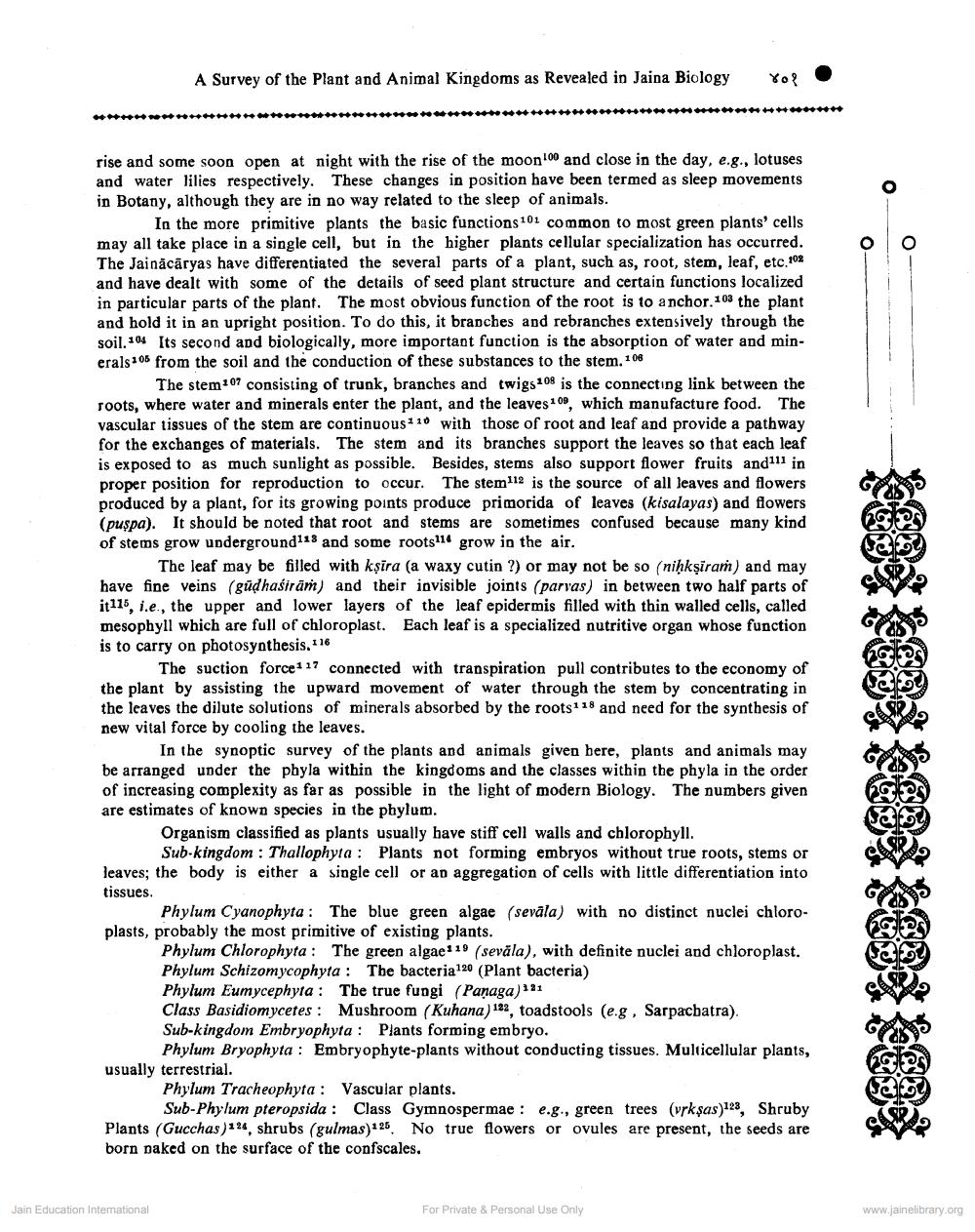________________
A Survey of the Plant and Animal Kingdoms as Revealed in Jaina Biology
rise and some soon open at night with the rise of the moon 100 and close in the day, e.g., lotuses and water lilies respectively. These changes in position have been termed as sleep movements in Botany, although they are in no way related to the sleep of animals.
In the more primitive plants the basic functions 101 common to most green plants' cells may all take place in a single cell, but in the higher plants cellular specialization has occurred. The Jainācāryas have differentiated the several parts of a plant, such as, root, stem, leaf, etc. 102 and have dealt with some of the details of seed plant structure and certain functions localized in particular parts of the plant. The most obvious function of the root is to anchor. 103 the plant and hold it in an upright position. To do this, it branches and rebranches extensively through the soil. 104 Its second and biologically, more important function is the absorption of water and minerals 105 from the soil and the conduction of these substances to the stem. 108
४०१
The stem107 consisting of trunk, branches and twigs 108 is the connecting link between the roots, where water and minerals enter the plant, and the leaves 109, which manufacture food. The vascular tissues of the stem are continuous 110 with those of root and leaf and provide a pathway for the exchanges of materials. The stem and its branches support the leaves so that each leaf is exposed to as much sunlight as possible. Besides, stems also support flower fruits and111 in proper position for reproduction to occur. The stem112 is the source of all leaves and flowers produced by a plant, for its growing points produce primorida of leaves (kisalayas) and flowers (puspa). It should be noted that root and stems are sometimes confused because many kind of stems grow underground118 and some roots114 grow in the air.
The leaf may be filled with kṣira (a waxy cutin ?) or may not be so (niḥkṣiram) and may have fine veins (gudhaśirām) and their invisible joints (parvas) in between two half parts of it115, i.e., the upper and lower layers of the leaf epidermis filled with thin walled cells, called mesophyll which are full of chloroplast. Each leaf is a specialized nutritive organ whose function is to carry on photosynthesis. 116
The suction force117 connected with transpiration pull contributes to the economy of the plant by assisting the upward movement of water through the stem by concentrating in the leaves the dilute solutions of minerals absorbed by the roots118 and need for the synthesis of new vital force by cooling the leaves.
In the synoptic survey of the plants and animals given here, plants and animals may be arranged under the phyla within the kingdoms and the classes within the phyla in the order of increasing complexity as far as possible in the light of modern Biology. The numbers given are estimates of known species in the phylum.
Organism classified as plants usually have stiff cell walls and chlorophyll.
Sub-kingdom: Thallophyta: Plants not forming embryos without true roots, stems or leaves; the body is either a single cell or an aggregation of cells with little differentiation into tissues.
Phylum Cyanophyta: The blue green algae (sevāla) with no distinct nuclei chloroplasts, probably the most primitive of existing plants.
Jain Education International
Phylum Chlorophyta: The green algae 119 (sevala), with definite nuclei and chloroplast.
Phylum Schizomycophyta: The bacteria 120 (Plant bacteria)
Phylum Eumycephyta: The true fungi (Panaga)121
Class Basidiomycetes: Mushroom (Kuhana) 122, toadstools (e.g, Sarpachatra).
Sub-kingdom Embryophyta: Plants forming embryo.
Phylum Bryophyta: Embryophyte-plants without conducting tissues. Multicellular plants, usually terrestrial.
Phylum Tracheophyta: Vascular plants.
Sub-Phylum pteropsida: Class Gymnospermae: e.g., green trees (vrksas) 123, Shruby Plants (Gucchas) 124, shrubs (gulmas) 125. No true flowers or ovules are present, the seeds are born naked on the surface of the confscales.
For Private & Personal Use Only
www.jainelibrary.org




